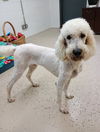|
|
How to Prevent Your Dog from Jumping on You and Yours By Jess Rollins PetExpertise
We are human. We tend to pay little attention to our dogs when they decide come to us, stand with us, and walk with us. However, when they jump on us we stop what we are doing, face them, speak to them, and put our hands on them until they are back on the ground. Then we immediately ignore them again! We feed them, open doors for them, and touch them, all while they jump. Obviously this is not helping the situation. We need to train the humans!
It is important to avoid punishing (shouting "no", kneeing, etc) a dog who is jumping up because this could result in your dog no longer wanting to greet people or becoming fearful of them. When a dog does jump up on you it is best to turn your back on them and only give your attention to a dog with "4 on the floor".
Instead of teaching your dog "off" which requires him to be "up" in the first place, we can cue "sit" which most dogs have already been introduced to. In addition, we will attempt to teach him that jumping up does not lead to attention.
New Doggie LAW: The only way to get attention from people is by keeping all four paws on the floor. The most important part of this training is to absolutely prevent him from being given attention for jumping up.
You will need at least 10 people to practice this lesson with your dog for him to understand that he will only get attention by remaining on the ground and that this rule applies for all humans. If you don't have enough people to help you practice you can teach him to remain grounded for his family and then teach a really solid sit-stay to deal with others.
It is also often helpful to desensitize your dog to the sound of the doorbell.
I. Teach Him Not to Jump on Family Members:
It is easiest to teach your dog not to jump on the family and frequent visitors because he has many more opportunities for learning, also, everyone is (hopefully) on the same page and doesn't mind doing a little training. When you come in from outside, and your dog begins to jump, say "oops" and immediately leave through the door. Repeat after a few seconds. Give him lots of attention when he is finally not jumping. Have everyone do the same exercise when coming home. If he is jumping on family other times besides when you enter, be sure to ignore that and put work into giving your dog attention when he is sitting.
II. Teach Him Not to Jump on Everyone Else:
Prevention is key here, especially with a large dog. You can prevent a dog from jumping up by using a leash, tie-back, crate or gate. Until you have given your dog enough practice to know what you want him to do, you should make sure you are using one of these methods to prevent him from hurting anyone or by perhaps being rewarded by jumping and getting a nice pat.
1. Dog training volunteers (infrequent visitors)
- In the Home: the guest comes in the door and when jumped on says "oops" and leaves as in the family members exercise. Practice this with 5 different people. Encourage them to do multiple entrances in the same visit.
- On the Street: Have your dog on leash. The guest will then move towards your dog. If the dog strains at the leash or begins to jump, the guest will turn and walk away a bit. When the dog calms itself again the guest will continue towards the dog. Continue until the guest can pet and great the dog and then have the volunteer repeat her approach a few times.
2. Guests who aren't interested in training the dog:
- Make a tie-back attach an extra leash to something sturdy, within view of the doorway, but not blocking the entrance and keep it there for the next few months. When a guest arrives, hook the dog up to the secured leash and let the guest in.
- Once your dog is calm, the visitor can attempt to greet him if they wish. Give him treats for calm behavior if the guest does not wish to greet him. If he barks, take him to his crate for a time out.
- If he is able to greet them on the tie-back calmly, he may be released (you may want to hold on to the leash just to be sure!).
3. Alternative method #1: Teach your dog that crossed arms equals a hand signal for "sit", then you can simply ask guests/strangers to cross their arms and wait for the dog to sit until being petted. (This will help you with people who unintentionally do things to get the dog all excited like waving their hands around).
4. Alternative method #2: Teach your dog that each time he would like to greet someone, treats will be tossed about 6-10 feet away from the person. You can easily accomplish this by keeping some treats by the door and tossing them as you come in. He should start to anticipate this and begin to stay away (and therefore, off of them!) from the person to get the treats. Once he has calmed down a bit you can then ask him to sit and give him some attention.
|
|

